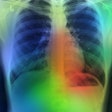Wednesday, November 30 | 3:00 p.m.-4:00 p.m. | W7-SSIN06-3 | Room S404
In this imaging informatics scientific session, researchers will present a real-world performance study of an artificial intelligence (AI) algorithm designed to detect pneumothorax on routine chest x-rays from the intensive care unit (ICU).A team at University Hospitals Cleveland Medical Center in Ohio found that the algorithm was highly accurate and that it improved radiologist reporting times. The researchers culled images of 27,399 consecutive frontal chest x-rays acquired between August 2020 and April 2021. Of these, 12,728 included the use of a commercially available AI tool (Critical Care Suite, GE Healthcare) on portable x-ray machines and 14,761 were acquired on conventional systems without AI.
According to the findings, 1,402 chest x-rays were flagged as positive for pneumothorax and 11,326 were negative for pneumothorax by the algorithm. The AI tool produced an area under the curve (AUC) of 0.78, with a sensitivity of 60.4% and specificity of 96.6%. When selecting for clinically actionable pneumothorax, AUC and sensitivity increased to 0.92 and 89%, respectively, with a specificity of 96.6%.
In addition, in studies with confirmed pneumothorax, reporting time for the pneumothorax-positive AI group was less than half compared to the control group, with a median of 104 minutes versus 260 minutes, (p < 0.0001).
“As a result of AI-augmented workflow, routine studies with [pneumothorax] were accurately flagged by AI and received urgent clinical interventions,” noted radiology resident Dr. Kaustav Bera, who will present the study.




















